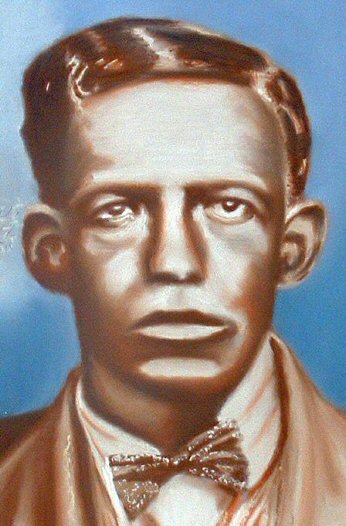
Painting © 2004 Loz
Arkle
Website
© Copyright 2000-2011 Alan White - All
Rights Reserved
Site optimised for Microsoft Internet Explorer
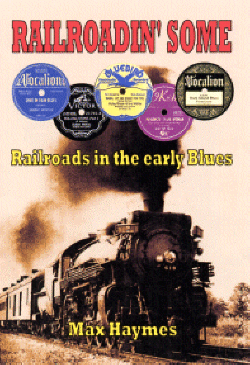
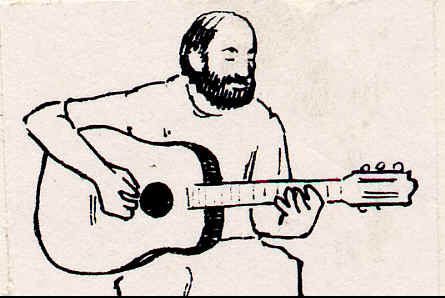

Back to the Land of California….
- Robert Johnson & "Sweet Home Chicago"
by Max Haymes
Robert Johnson’s phrase “back to the land of California to my sweet home Chicago”, (the latter three words of which give the title to his Vocation record from 1936) has in the past, been queried by Blues writers as to his geographical sanity!! But as I maintain that the Blues singer rarely sang lyrics which were meaningless, Johnson had a reason for singing such a line. This article is an attempt, if you like, to ‘justify’ Johnson’s apparent nonsensical phrase. Footnote 1
Apart from the Johnson recording, only 2 other issues appeared in the pre-war era (1890-1943) using the “California/Chicago” phrase. In 1939 Tommy McClennan, the harsh-voiced delta guitarist, called it “Baby, Don’t You Want To Go?” (BB B8408) which surpassed Johnson’s song for emotional intensity and sheer energy. Two years later, the superbly laid-back pianist Walter Davis, based in St. Louis, recorded “Don’t You Want To Go?” for the same label, Bluebird (BB B9027). I also maintain that all three of these recordings imply “the land of California OR sweet home Chicago.”
The reason being that either Chicago (or any other northern city for that matter) or anywhere in California would be a far more civilised place to live, than the then race-torn South. Although the general trend has always been to observe that blacks did not emigrate to the West Coast in any numbers much before the 1940’s; this does not give the full picture. As early as 1860 blacks were arriving in San Francisco in “Relatively equal numbers... from northern and southern states.. .“(1). Although the numbers of black immigrants was small compared to those going to Chicago, New York, Detroit, etc. it was nevertheless a steady stream, so that by 1900 the black population of San Francisco and Los Angeles was 1,654 and 2,131 respectively (2). In this year New York was home to 60,666 and Chicago 30,150, by way of comparison. But while “black Los Angeles mushroomed between 1890 and 1940”(3), and reached a population figure of 63,774 by the latter year, San Francisco could only claim 4,846 black citizens, although nearly twice this number were now in nearby Oakland, Ca. Daniels adds that around 1900 “Black railroad men often settled in Oakland, the terminus for the Central Pacific, Southern Pacific, and Western Pacific railroads.”. Many of them “worked on the trains at some time in their careers;”(4). The main attraction was the comparative freedom found on the West Coast, which was denied them in their southern home states. As one Texan informant told Daniels several decades after moving to San Francisco c. 1917: “To me, it was heaven. It was just like coming from hell to heaven. That’s how I felt about it.”(5). Another writer concurs: “A harbinger of the World War II flood of immigrants to California came when some blacks departed for that state in 1907 from Americus (in Georgia). Some whites blamed this on the adoption of Prohibition, but the black press said that disfranchisement, unequal education, taxation of blacks for the education of whites, and confederate pensions were to blame.”(6). Not to mention some of the most brutal and inhuman atrocities suffered by blacks at the hands of the white lynch mobs.
The notion that California was “wide open” and much less radically oppressive than the South, was reflected in the Blues at least 12 years prior to Robert Johnson’s recording of “Sweet Home Chicago”. Also, rail travel to California became much more readily accessible as far back as the 1880’s, for would-be southern black immigrants, legal or otherwise. On January 12th 1883, the Southern Pacific (nee Central Pacific) completed the link from California to New Orleans “at a spot two and a half miles west of Pecos. . . “(7). Beebe continues “Through service between San Francisco and New Orleans was established within a month.”(8). The route from Yuma, Ca. via El Paso, Tex. through San Antonio and Houston to New Orleans “was nicknamed the “Sunset Route” and eventually became the most heavily used single-track freight route in the world.”(9). A major attraction also, to the hobo, both black and white.
Of course, the second great transcontinental railroad (after the C.P.-Union Pacific link-up at Promontory Point, Utah, in 1869) was the meeting of the S.P. with the Santa Fe at “Denning, New Mexico just west of El Paso, Texas in 1881.” (10). At this time, the Santa Fe served parts of East Texas such as Galveston and Houston. Indeed, it is from this railroad’s name that the ‘Santa Fe group’ of Texas blues pianists drew their title; Son Becky and Rob Cooper among them. In the next five years the Santa Fe reached Los Angeles (1887) when L.A. “was still a sleepy Mexicanesque town.” (11). it was “shortly thereafter. . .to enter San Francisco - a relatively old and well-established city by then - and San Diego, and it served all three with two trains a day out of Chicago’s picturesque Dearborn Street Station.”(12).
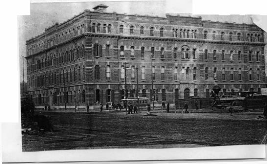
[General offices of the S.P., with the depot at right, in 1887 at Fourth & Townsend in San Francisco.]

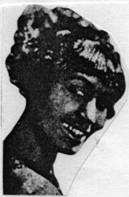 In
1924,Virginia Liston who was an above average vaudeville-blues singer, cut her
“San Francisco Blues”.
In
1924,Virginia Liston who was an above average vaudeville-blues singer, cut her
“San Francisco Blues”.
It runs in part:
“Out in California, that’s where you’ll hear the Blues;
That’s where they play the Blues an’ sing ‘em all night long.
‘Cos I’m goin’ to leave for California my home.”
“For the train runs, all this time;
In that dear old sunny clime.
That sweetie man of mine;
I’m waitin’ all the time.
He’s singin’ the “Frisco Blues”;
He sings ‘em all night long.
That’s why I got the blues for California my home.” (13)
About 6 months later, Clara Smith (one of the ‘big 4’ vaudeville-blues singers) covered this song and made a more sensual blues out of it; despite the 2 clarinets in the accompaniment! While Ada Brown’s “Tia Juana Man” from 1926 is given a more rural treatment in April 1929, by Helen Beasley who also intends to travel south of the border.
“I’m goin’ to California, sweet man, just to wear you off my mind;
I’m goin’ to California, baby, just to wear you off my mind.
I’m gonna flag Tia Juana, baby, hey-hey; to spend my leisure time.” (14)
Tia Juana lying immediately south of the California/Mexico border. Beasley’s pianist nevertheless oddly invoking ‘Georgia Tom’ Dorsey on a 1928 recording which was strictly vaudeville or minstrelsy, as part of his/her instrumental response. This was Dorsey’s accompaniment to “Stovepipe Johnson” who sings “Green Grass” in a ‘green grow the rushes o’ format! B. & G. R. list Beasley’s piano player as “prob. Frances Wallace.” (15). Interestingly, a week earlier, Helen Beasley recorded a “California Bound Blues” which remains unissued and is presumably a version of “Tia Juana Blues”.
Although Beasley indicates she wants to go to California to get over a failed relationship, St. Louis-based pianist Walter Davis obviously thinks that the “Golden State” which he refers to as ‘strange lands’ is the solution to all his problems, implying racial discrimination as a major one.
“I often think of strange lands, a place where I have never been before;
I often think of strange lands, place where 1 have never been before.
Because I’m having bad luck, here—everywhere I go.”
“Out in California, that’s where I long to be;
Way out in California, that’s where I long to be.
Because my trouble an’ worry has really came down on me.” (16)
The last verse recalling a Barbecue Bob title made one week earlier than the Beasley record, in Atlanta, Ga. On his “California Blues” (Co 14573-D). Bob refers to “wild women in California, where I so long to be.” He also takes a thinly-veiled swipe at the KKK (surely unique in this early period) when he considers the frightening results if discovered hoboing on a train to that state, by “the man”. Probably referring to one of the white railroad police.
“The longest train I ever rode was 79 coaches long;
Longest train I ever rode was 79 coaches long.
But if the man had-a see’d me, round the mountain I’d-a been gone.” (17)
The mountain reference is directed towards Stone Mountain over-looking Atlanta and where at night, the KKK would often brandish a display of fiery crosses designed to strike terror into the hearts of black citizens in the city during the first decades of the 20th century. Atlanta had been the scene of a terrible race riot (started by whites) back in 1906 and I have no doubt that the KKK were actively involved. Resulting in many deaths of black citizens, horrific injuries to many more, and wholesale destruction of black property, it is little wonder that some 23 years on that Barbecue Bob concluded his blues with these lines:
“I was on my way to California, where I so long to be. (x 2)
Honey, I’m from Missouri, you have to side me.” (18)
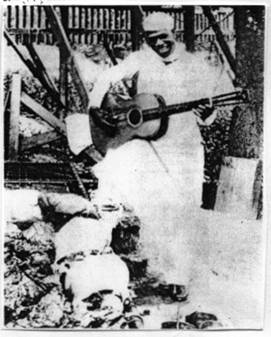 Perhaps
Bob (aka. Robert Hicks, from Georgia) was having second thoughts about the
‘mountain verse’ by the end of his blues and yet did not want to omit it. This
might explain his statement of being “from Missouri” in an attempt to extend his
anonymity, as well as by use of his pseudonym, for his own safety and peace of
mind. After all, there could easily be more than one “Barbecue Bob” as there
were “Tampa Reds”
and “Sonny Boy Williamsons”. It’s interesting to note Bob’s use of the term
‘coach’ when referring to railroad cars, on a freight train on this occasion.
Perhaps
Bob (aka. Robert Hicks, from Georgia) was having second thoughts about the
‘mountain verse’ by the end of his blues and yet did not want to omit it. This
might explain his statement of being “from Missouri” in an attempt to extend his
anonymity, as well as by use of his pseudonym, for his own safety and peace of
mind. After all, there could easily be more than one “Barbecue Bob” as there
were “Tampa Reds”
and “Sonny Boy Williamsons”. It’s interesting to note Bob’s use of the term
‘coach’ when referring to railroad cars, on a freight train on this occasion.
Barbeque Bob Publicity pic - 1927
This must be an almost unique usage in Blues which harks back to the days of the stagecoach. Also the word scans better than the more usual ‘car’.
Some 6 years later, in 1935, another guitarist who was possibly from Mississippi, Lane Hardin, would echo Bob’s theme of danger when trying to hobo to California. Or from the whites’ point of view, when potential cheap black labour tried to leave the South. Hardin though, omitted the ‘mountain verse’.
“Crossin’ that old desert, mama, just like breakin’ the Hindenburg Line;
Crossin’ that old desert, just like breakin’ the Hindenburg Line.
Now, if you git ditched off’n that freight train, you know that will be the end of the line.” (19)
In World War I, the Hindenburg Line was named after Field Marshal Paul Von Hindenburg, who in 1917 along with General Erich Ludendorff was “in supreme command of all German armies,”(20). This ‘line’ was in fact an almost impregnable series of forts, machine gun nests and trenches, in France, set up by the Germans and referred to as the 'Siegfried Line’ “known to the Allies as the Hindenburg Line.”(21). Perhaps this W.W.1 reference indicates Hardin as being an older man, possibly born in the 1890’s. He employs a near-falsetto vocal which recalls bluesmen such as Sam Collins, Skip James and King Solomon Hill (aka. Joe Holmes). Coupled with his oddly-tuned and insistent guitar. Hardin portrays an Arabic feel in his blues in much the same way as Skip James on “Hard Time Killing Floor Blues”, for example, in 1931, and to a lesser extent King Solomon Hill in his only session, in 1932, and Charlie Pickett on his mesmeric “Down The Highway” from 1937. This ‘Arabic feel’ also presents itself in some of the post-war recordings made by Texas guitarist Li’l Son Jackson. Check out “Johnnie Mae” from 1960 (on Arhoolie) for instance, with its ‘sing-songy’ vocal and vastly different guitar style. Lane Hardin in fact seems to be returning to California, rather than making a first-time visit.
“I’m goin’ back to California, where I can do as I please.” (22)
More than hinting that Californians (black and white) were unaware of the often horrendous racialist conditions in the South.
“Now, the people in Los Angel, (sic) they didn’t know what it was all about.” (23)
Indeed, railroad man Edward J. “Buster” Johnson (not the singer with the Tommy Bradley outfit) who worked on the trains all the way down the Pacific Coast, tends to support this view indicating the social conditions in San Francisco were much more liberal and free from racial restrictions. Not only in ‘Frisco and Los Angeles but “Up and down the coast,. . . Seattle, Portland. . . --it was all the same. . . Negroes lived the same as they did here all the way up and down the coast.” (24). There seemed to be no Jim Crow restrictions on public transport, as Johnson adds “you paid your fare and sat down and rode and you didn’t have to ride at the back of the bus or somewhere else, just wherever you could find a seat. We didn’t have none of that funny stuff like they had in the south.” (25). Presumably he also meant on the trains in San Francisco where” ‘the railroad’ meant the Southern Pacific.” (26).
Several blues reflected a longing to go to the ‘land of California’ even if this was only implied without mentioning the state. Memphian Furry Lewis features one of the few references to the Southern Pacific in the Blues, in Part 2 of his version of “Casey Jones”.
“Mr. Casey said before he died;
One more road an’ he wants to ride.
People tell Casey, which road did he (ride);
Southern Pacific an’ the Santa Fe:
Santa Fe........” (..... = guitar finishes vocal line) (27)
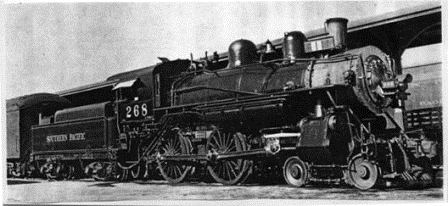
[The Ennis, Tex. local train arriving at Fort Worth c. 1947]
Lewis pronounces it “Sancta Fee” while the Vocalion record executives print the title as “Kassie Jones”. Three years later, at his only pre-war session, Mississippi’s Skip James only half-remembers the Furry Lewis verse. A habit he was prone to, according to his biographer Steve Calt. “Indeed, he did not necessarily understand his own lyrics, when they were acquired from another source.” (28). Although Calt’s book tends to reveal as much about the author’s persona as it does that of Skip James, there does seem to be an element of truth in his statement. The third title of James’ 1931 session was “Cherry Ball Blues”
“I catch the Southern an’ she takes the Santa Fe;
I take the Southern an’ you take the Santa Fe.
Ah! When I ‘rrive in Helena, tell cherry (to) come back to me.” (29)
Neither the Southern nor the Santa Fe served the state of Arkansas, let alone Helena just across the Mississippi River. Skip James appropriates the Furry Lewis pronunciation of the latter road which he nevertheless sings as “Sant-eye Fee”. Any rail journey a southern traveller chose to take if he/she desired to go to California, would ultimately end up on either the Southern Pacific or the Santa Fe. By the end of 1939 one statistics table shows these 2 roads, for example, had the greatest mileage in Texas - 3,665.44 and 3,657.67, respectively. (30).
Both the Furry Lewis and Skip James verse could probably be traced back to the seminal Blues man from East Texas, Blind Lemon Jefferson. On his “Bad Luck Blues” (Para 12443) from 1926, he refers to both the Santa Fe and also the Missouri-Kansas-Texas RR. (M-K-T or the ‘Katy’). The latter ran north to St. Louis, Mo. where his girl friend could change to the Santa Fe and head out west. In the meantime Lemon could pick up the Santa Fe 4 or 5 miles east of his home-base in Wortham, Tex. and stop off in Denver, Col., as a meeting point before they could both consider taking the option to ride all the way to San Francisco.
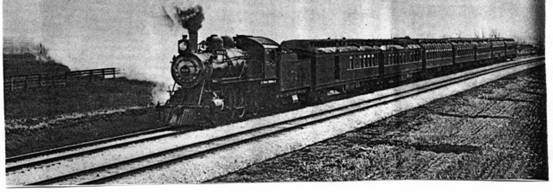
[Santa Fe de-Luxe on an initial run in 1911]
“Sister, you catch the Katy, I’ll catch that Santa Fe,
Doggone my bad luck soul;
Sister, you catch that Katy, now, I’ll catch that Santa Fe.
I mean Santa, speakin’ about Fe, when you get in Denver, pretty mama, look around for me.” (31)
As can be seen from the Skip James example quoted, Blues lyrics cannot always be relied on to glean biographical and / or historical facts. For instance Furry Lewis mixes up the incident of Casey Jones in 1900 with another fatal one in 1910, when engineer Billy Richardson (also white) was killed on the fast mail train running on the C. & O. This railroad runs through West Virginia to Newport News, A very popular recording by hillbilly singer Vernon Dalhart was made some 2 years before “Kassie Jones”, in 1926 to mark the occasion and entitled “Billy Richardson’s Last Ride”. Further to this, the Blues singer may often be portraying his or her concept of the world as they see it. (Footnote 2). For example, not all earlier railroads actually served the locations in their title! If we consider the St. Louis & San Francisco Railway (or the Frisco), we find it never got within a 1,000 miles of the Californian city. Paul and Beth Garon observed in their otherwise essential publication on Memphis Minnie, that “Actually, the Frisco Railway was formed by the merger of the St. Louis and San Francisco Lines,”(32). But in fact the Frisco was organised in 1876 after the “ambitiously named Atlantic & Pacific went up the spout in the panic of ‘73...” (33). The Frisco bought half of the A. & P. which terminated in Kansas City, Mo. and “the competing Santa Fe acquired its valuable line from Albuquerque (in New Mexico) to the Colorado River.” (34). The Garons comment that Memphis Minnie’s “Frisco Town” from her first session in 1929, in the title and lyrics “suggested to many that the ‘Frisco Train was simply the train bound for San Francisco.” (35). While the lyrics, in the first verse, confirm rather than suggest this scenario, the title did not necessarily translate to black listeners that this train was headed for California. Certainly, many of the blues-buying public would be aware that the Frisco could not make the journey. What Minnie’s title conveyed to them was her intent to head for a depot (probably in Chicago or Memphis) where she could catch the Frisco heading for St. Louis and change over to the Santa Fe if she wanted to get to the West Coast. Or alternatively she was simply announcing her intent to travel to a destination unknown. As Henry Thomas stated “I’m on my way but I don’t know where.” (36).
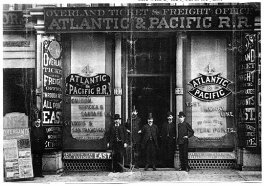
['Gentlemen' clerks pose outside Los Angeles offices - c. 1876]
In one short sentence, Henry Thomas, from Big Sandy in Upshur County, East Texas, conveys some idea as to what ‘freedom’ meant to African Americans, and this sense of freedom was often linked with “the land of California” of Robert Johnson’s blues. Thomas’ fellow Texan Gene Campbell, after declaring he is going to leave Texas for good, “I’m through”, sets out to cover the U.S. from coast to coast. First of all travelling from the north-westernmost state to San Francisco by ship and presumably hoboing on trains back to New York City before apparently changing his mind about Texas.
“Goin’ to sail from Maine to the Golden Gate;
I’m goin’ to sail from Maine to the Golden Gate.
From New York City, back to the Lone Star State.” (37)
His wanderings easily matching those of hobo supremo Henry “Ragtime Texas”. But by his closing lines the thought of the West and probably California draws him to the station yard where the freight trains are being made up.
“Goin’ to the station, catch me armful of train;
I’m goin’ to the station, catch me armful of train.
I’m goin’ to wake up Monday mornin’ out on the Western Plain. (38)
Campbell’s closing phrase would be invoked by Leadbelly in 1943 on the latter’s “Out On The Western Plains” recorded for the Library of Congress. In 1932 Tampa Red, the “Man With The Golden Guitar” sang in similar vein on “Western Bound Blues”.
“What’s the use of walkin’, boys, when there’s a freight train goin’ your way?
What’s the use of walkin’, if there’s a freight train a-goin’ your way?
Spoken: “I heard the thing blowin’.”
If my mind don’t change, I’m western-bound today.” (39)
Two years later Tampa would record a “I Still Got California On My Mind” for the Bluebird label.
Several other blues recorded over a decade or so, reflected in their titles, a mind to go out west if not always all the way to California. These included “West Coast Blues” (1926) by Blind Blake, “Western Traveler Blues” (1929) by Turner Parrish, “The Western Blues” (1930) by Frank Brasswell, “Out West Blues” (1936) by both Little Brother Montgomery and Cooney Vaughn, “West Coast Blues” (1937) and “Western Land” (1939) by Walter Davis. (Footnote 3). The last-mentioned Davis side was also ‘covered’ by James Wright as “Western Land Blues” in 1942 for the Library of Congress. To this list could be added many other recorded pre-war blues which refer to California in the lyric, of that I’m sure.
It is obvious that the “land of California” (and the West generally) was a major haven of freedom, every bit as much as Chicago, in the minds of many African Americans, including of course Blues singers, long before the mass migration in the 1940’s. Joe Pullum, Lucille Bogan and “Moanin” Bernice Edwards, for example made their way to the West Coast by 1945. Usually either in Los Angeles or Oakland, Ca. While a pianist called James David Nicholson from Monroe, La. had moved to Los Angeles as early as 1926. (40). And 70 year-old Memphis resident Lum Guffin, who missed out on the pre-war recordings (and I wonder how many more?) recalled in 1973 for Bill Barth, his hoboing days in the 1920’s and ‘30s. “Lum tells of riding trains to California to stay with his brother who lived in Oakland, hopping freights, riding the M. & 0., the Southern Pacific, and the Illinois Central, he says of his experiences “you gotta stay with it, that’s what hoboin’ is”.” (41). Both the IC. and the M. & 0. (Mobile and Ohio) served Lum’s hometown of Memphis, Tenn.
There were several reasons, I believe, why blacks did not flock to California’s coastal cities as they did to Chicago, New York, and Detroit, prior to World War II. Firstly, and most importantly, there was no obviously major industry on the West Coast in that era to compete with say the car industry in Detroit; the steel works in Gary, Ind. and Pittsburg, Pa.; the stock yards and meat-packing factories in Chicago; or the massive dock operations in New York City. There was also no “Chicago Defender” (the most well-known black newspaper in the Blues world) to advertise, advocate and cajole black citizens to move from their southern locations to San Francisco or Los Angeles. Plus the fact that in the South unless you lived in East Texas or southern parts of Louisiana, there was no direct route to California cities, unlike Chicago in the North, on the Illinois Central. A traveller would need to go north to St. Louis to change over to the Santa Fe, by which time he/she would already be half-way to Chicago. Or travel south to New Orleans to get the Southern Pacific, alternatively go to Houston using the south-bound Santa Fe that Blind Lemon also refers to on his “Bad Luck Blues”. However, there was some seasonal work which was booming in the Golden State - the fruit industry. Oranges, lemons and later grapefruit formed a thriving citrus industry serving the whole of the U.S., although never matching the output from Florida. But this depended on a safe form of transport which was duly perfected in the 1880’s - the refrigerator car, or ‘reefer’.
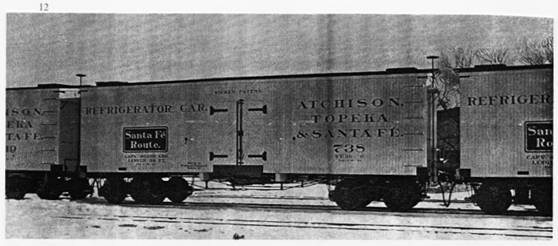
[Santa Fe Refrigerator Despatch class D cars were built by Pullman in 1894. Numbered 720-969, these 36-foot cars were built with Wicke’s patent of ice refrigeration. It is not known if the sides of these cars were white, grey, or a light yellow in color. -SMITHSONIAN, PULLMAN NEC. 2523]
As John White relates “The Atchison, Topeka & Santa Fe Railway established the Santa Fe Refrigerator Despatch in 1884 to handle and generate perishable traffic.” (42). White says defensively that the Santa Fe “was not 15 years behind the transcontinental Southern Pacific- Union Pacific route as the reader might believe. Santa Fe rails were still moving westward when the SFRD was established.” (43). But by 1887 the franchise of the “Atlantic & Pacific. . .had been acquired and the purchase of Southern Pacific’s Mojave-Barstow-Needles line completed, providing the Santa Fe an entrance to California.” (44). Another local line was bought, The California Southern, and “in 1887 the Santa Fe reached Los Angeles over its own rails.” (45). Perhaps Blues singers like Lum Guffin, and by inference, Lane Hardin, paid seasonal visits to Oakland, L.A., etc. to entertain and make some money from the growing number of black farm workers within the California citrus industry.
One of these ‘seasonal’ Blues singers could well have been Robert Johnson. As well as travelling in the Delta he also went to “St. Louis, Chicago, Detroit, and New York. . .“ (46) as he became better known. As Johnny Shines, who ‘ran’ with Johnson (i.e. travelled and played with him) said: “See, Robert was a guy, you could wake him up anytime and he was ready to go.. You say, ‘Robert, I hear a train; let’s catch it’. He wouldn’t exchange no words with you; he’s just ready to go.” (47). Just after Johnson’s last session for A.R.C. in San Antonio, Tex. 1937, Johnny Shines said that they met up in Red Water, Texas. That’s in Bowie County some 10 miles south-west of Texarkana, Ark. - on the state line. This would be in late June and Shines recalls “We worked Texas until the cold weather began to set in, then we headed for the southern part of Texas.” (48). They ended up in Hughes, Ark. near where Johnny Shines’ mother was living at the time. Johnny stayed on in Hughes but “Robert went on,” (49). Indeed, and Robert Johnson more than likely went on to, among other places as already noted, the land of California. Certainly, after his 3 sessions in 1936 in San Antonio, he could have easily flagged a ride on the Southern Pacific main line in that city. The latter being a major stop on the Sunset Route on its way to Los Angeles. (Footnote 4). It would seem that, certainly Johnson’s “old evil spirit” made its presence felt on the West Coast. From the Johnny Otis recollection of hearing “Terraplane Blues” being played on a phonograph by Pullman porters selling records in his local market in the 1930’s, to the apparent lyric influence on rural blues man, Norman Green’s performance in 1948, on his “Central Avenue Blues”. Central Avenue being the main drag in L.A., had already been celebrated in a pre-war recording “Blues On Central Avenue” by Kansas City blues shouter Big Joe Turner in 1941. (Footnote 5). With Johnsonian overtones in some of his vocal phrases, Green finishes his song recalling Robert Johnson’s “I Believe I’ll Dust My Broom” from 1936.
“Said, no man want a woman that comes staggerin’ all up an’ down the street. (x2)
Because that woman, she’ll get drunk with every man she meet.” (51)
‘Slim’ Green (who used his cousin’s initial ‘R’!) featured a great vocal and stinging guitar which were complemented by Turner’s (presumably no relation to Big Joe!) ethereal and magnificently ‘out of tune’ harp. The overall effect is one of an archaic blues in the best sense of the term. The Robert Johnson verse ran:
“I don’t want no woman wants every down town man she meets. (x2)
She’s a no-good dony, they shouldn’t allow her on the streets. (52)
Johnson’s description (‘dony’ is a term derived from mid-nineteenth century London referring to a girl friend) could well be applied to the woman with whom his involvement was to result in his eventual murder in 1938 at the juke joint in Three Forks near Greenwood in the Mississippi Delta. In his last verse of “Sweet Home Chicago”, Robert Johnson seems to have made up his mind when he sings “I’m goin’ to California,” (53). Perhaps he had a long-term premonition of how he was going to end.
Sometime during the last year that Robert Johnson was living (1938) a slightly younger man, Mercy D. Walton, moved to California. Walton. usually recorded as “Mercy Dee”, was a superb blues pianist with a laconic, smoky vocal style who painted often graphic verbal pictures of his past experiences in East Texas. Born in that state at Waco in 1915 (54), he started recording in Fresno, Ca. in 1948 and until 1955 “was a popular performer recording quite frequently...” (55). At some point before 1938, Mercy Dee was incarcerated at Sugar Land in the state pen for a shooting. This was in Fort Bend County in East Texas. Officially the Central State Farm it was known usually as “Sugar Land” after the town’s name. It has the notoriety of featuring the cell bars through which the headlight of the “Midnight Special” shone on the hapless prisoners. Situated down in the “Brazos Bottoms” (along the Brazos River) it was one of the most hellish prison farms in the Southern penal system. The more famous Leadbelly of course was also interred there for many years and made up his version of the song “Midnight Special” while serving his time. The train in the title ran on the Southern Pacific rails which left “Houston every night a few minutes after eleven for San Antonio and points west.” (56). By his own admission, Mercy Dee was probably a teenager (c. 1927) when “all my troubles started"
“Now, since my trouble started early, at the time I should have been home in bed;
All my troubles started early, at the time I should have been home in bed.
I shot a man about a no-good woman, an’ she wasn’t worth the salt it took to make her bread.”“They sentenced me to ten years on Big Brazos, pickin’ cotton an’ corn, an’ listen to the big bell moan;
They sentenced me to ten years on Big Brazos, pickin’ cotton an’ corn, an’ listen to the big bell tone.
Now, every time I hear a street light jingle, I start achin’ all in my bones.”
(Footnote 6) (57)
After finishing his sentence, Dee finds he cannot get a decent job or woman! So he is going to take a train and ride to the West.
“I have to freight an’ move to California, boy, I really thought things would change;
I have to freight an’ move to California, boy, I really, really thought chay- things would change.
But if I ain’t cuttin’ spinach, I’m pickin’ grape, people; an’ if fog rolls in I’m right back down on Skid Row again. (58)
The beauty of the haunting piano and poetic lyrics is only enhanced by his mis-speaking on this side recorded for Chris Strachwitz in 1961 which lasts nearly 10 minutes! His harsh experiences in Sugar Land would be another good reason to leave for the West Coast as well as the more liberal racial/social climate he would find there. Even if he was still tied to ‘agricultural slavery’ or just being out of work. Perhaps if Robert Johnson had decided to “freight an’ move to California” sometime before that fateful night in the Three Forks juke joint he might be alive today!
Although black workers in pre-war California (and indeed since W.W.II) had much to sing the Blues about - low pay and high cost of living, etc. as Strachwitz pointed out “But in some ways life is better than it was “back home” in the deep South, where many of the people came from before trying their luck in the “Golden State”. A talented man has at least a chance out here and one of these was Mercy D. Walton - one of the finest blues men of his generation.” (59). And indeed Mercy Dee took that chance and on the “West Coast he toured a lot with the popular jump band of Big Jay McNeely and he met many of his contemporaries like Smokey Hogg and T-Bone Walker. They had all come from Texas but had found success in California.” (60). This is due in part to the positive attitude or ‘staying power’ of the Blues. As Mercy Dee sings in a resigned and yet strangely forceful way.
“Well, I’ve learnt to thumb an’ smile at trouble, I ain’t goin’ to let it get me down;
I’ve learnt to thumb an’ smile in trouble, I ain’t goin’ to let it get me down.
I’ll be drinkin’ dark port an’ tryin’ to make it, peoples, when the deal goes down.” (61)
Although for various reasons blacks did not move permanently to the West Coast in anything like the numbers who travelled to the North, until the 1940’s, nevertheless the foregoing hopefully shows that not only Chicago was seen as the “Promised Land” but also Los Angeles, Oakland and San Francisco. Robert Johnson would naturally give Californian cities equal consideration in his mind and indeed on his first use of the refrain from which this article drew its title. I maintain he sings, for the one and only time:
“back to the land of California OR sweet home Chicago,”
Copyright © 2002 Max Haymes. All rights reserved.
References
- Beebe Lucius “The Central Pacific and The Southern Pacific Railroads” Centennial Ed. Howell-North Berkley, Ca. 1963
- Martin Albro “Railroads Triumphant” Oxford University Press. New York and Oxford. 1992
- Dixon Robert M W, John Godrich and Howard W Rye “Blues and Gospel Records 1890-1943” (4th Edition). Clarendon Press. Oxford 1997
- Livesey Anthony “Great Battles of World War I”. MacMillan Publishing Co. N.Y. 1989
- Daniels Douglas Henry “Pioneer Urbanity”. (A Social and Cultural History of Black San Francisco). Temple University Press. Philadelphia. 1980
- Grant Douglas L. “The Way it Was in the South” (The Black Experience in Georgia). Birds Lane Press. 1993
- William and Robert W Cherry “San Francisco, 1865-1932”. California Press. 1986
- Colt Stephen “I’d Rather Be Blind” (Skip James and the Blues). Da Capo Press. 1994
- Reed S G “A History of the Texas Railroads”. Bono Press. N.Y. 1981
- Ibid
- Ibid
- Ibid
- "San Francisco Blues" Virginia Liston vo. prob. Clarence Williams pno.
- "Tia Juana Blues" Helen Beasley vo.; prob. Frances Wallace pno.
- Dixon Robert M W, John Godrich and Howard W Rye “Blues and Gospel Records 1890-1943” (4th Edition). P47. Clarendon Press. Oxford 1997
- "Strange Land Blues" Walter Davis vo.; Roosevelt Sykes (as "Willie Kelly") pno. 25/4/29 Chicago, Ill.
- "California Blues" Barbeque Bob vo. gtr. 18/4/29 Atlanta, Ga.
- Ibid
- "California Desert Blues" Lane Hardin vo. gtr. 28/7/35 Chicago, Ill.
- Livesey Anthony “Great Battles of World War I” p112 MacMillan Publishing Co. N.Y. 1989
- Ibid
- Hardin Ibid
- Ibid
- Daniels Ibid
- Ibid
- Insert William and Robert Cheery “San Francisco, 1865-1932”. California Press. 1986
- "Kassie Jones - Part Two" Furry Lewis vo. gtr. 28/8/28 Memphis Tenn.
- Calt Steve p114
- "Cherry Ball Blues" Skip James vo. gtr.
- Reed S G c. -/2/31 Grafton Wis. p442
- "Bad Luck Blues" Blind Lemon Jefferson vo. gtr.
- Garon Paul and Beth
- Beebe
- Ibid
- Garon Paul and Beth
- "Railroading Some" Henry Thomas vo. gtr. pan-pipes, speech
- "Western Plain Blues" Gene Campbell vo. gtr. c. -/5/30 Chicago, Ill
- Ibid
- "Western Bound Blues" Tampa Red vo. gtr. speech
- Scott F
- Barth B Notes to Flyright LP
- White G p162
- Ibid
- Ibid
- Ibid
- Guralnick P pp18-19
- Ibid p31
- Ibid p46
- Ibid
- Hubbard F p318
- "Central Avenue Blues" R Green and Turner; Norman 'Slim' Green vo. gtr.; Turner pno -/-/48 LA, Cas
- "I Believe I'll Dust My Broom" Robert Johnson vo. gtr. 23/11/36 San Antonio, Tex.
- "Sweet Home Chicago" Robert Johnson vo. gtr. 23/11/36 San Antonio, Tex.
- Strachwitz C A Notes to Arhoolie LP
- Scott Ibid
- "Wolfe C and K Lorrell p84
- Mercy's Troubles" Mercy Dee vo. pno.; Otis Cherry drums 12/2/61 Stockton Ca.
- Ibid
- Strachnitz Ibid
- Ibid
- Mercy Dee Ibid
Copyright © 2002 Max Haymes. All rights reserved.
Footnote 1
Robert Johnson seems to have been
the instigator of the “California/Chicago” phrase, on record at least. His song
is re-located from a blues back in the 1920’s “Sweet Old Kokomo”. The best-known
version is by Kokomo Arnold in 1934 as “Old Original Kokomo Blues” (De 7026).
Back to Text
Footnote
2
For a fuller discussion on the Blues singer’s (and hobo’s) concept, and
railroads - see “Railroadin’ Some” (Oral transmission. railroads & the Blues) by
Max Haymes. Publication pending, with Cambridge University Press
and due out in early 2003.
Back to text
Footnote
3
Actually “West Coast Blues” is a mis-heard rendering of the phrase ‘water
coast’. With the Davis line “don’t the Smoky Mountains look lonesome out across
the water coast”, it becomes obvious he is referring to the East Coast! About 14
years later a fine guitarist known only as “The
Sugarman”, sounding more than bit like Sam Montgomery from the pre-war era,
switched the location in another Davis verse from Dallas to New Orleans but
retained the ‘water coast’ phrase and thus the idea of the East Coast. It was
recorded in 1951 as “Which Woman Do I Love?”. In 1952 the obscure Ernest Lewis (aka
“West Texas Slim”, “Country Slim”. etc.) altered the phrase to relate back to
the title, i.e. “West Coast” in his use of the ‘water coast’ verse.
Back to text
Footnote 4
Southern Pacific's crack express the "Sunset Limited" until 1912 "linked New
Orleans with San Francisco...when its Western terminal was changed to Los
Angeles" (50).
Back to text
Footnote
5
Earlier recordings of “Central Avenue Blues” by Texas singers Texas’ Bill Day
(as “Will Day”) and Willie Reed in 1928 and 1935 respectively, refer to the
thoroughfare in Dallas, Tex. named alter the Houston & Texas Central RR. often
known as ‘the Central’, which ran down it. Normally referred to as “Central
Tracks”, a famous location for early Blues singers to congregate, such as Blind
Lemon Jefferson, playing for nickels and dimes.
Back to text
Footnote
6
Mercy Dee surely meant “street car”, then so prevalent in San Francisco. Los
Angeles, etc. There was usually a warning bell in the car sounded for the safety
of other vehicles and pedestrians.
Back to text
Webmaster's Note
This is an example of Max's railroading essays which have been issued in
book form. Please check out “Railroadin’ Some:
Railroads and the Early Blues" by Max Haymes.
Back to
essay
Text Copyright © 2002 Max Haymes.
All rights reserved.
Website © Copyright 2000-2008 Alan
White. All Rights Reserved.




